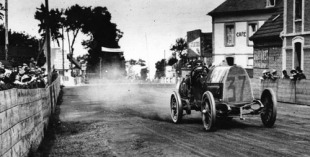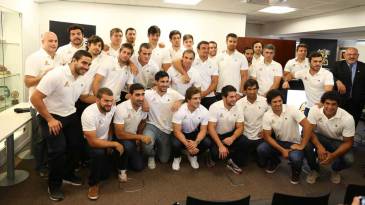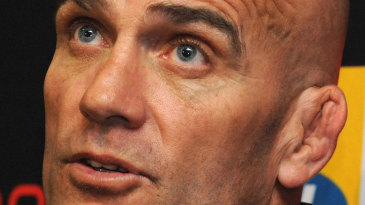
- Feature:
-
Deaths in Formula One
- Feature:
-
Formula One glossary
- Feature:
-
Rules and regulations
- Feature:
-
A brief history of Formula One
- Other pages:
- Constructors
- |
- Drivers' Champions
1901 The first use of the words grand prix to describe a race, the French Grand Prix at Le Mans.
1904 The formation of the Fédération Internationale de l'Automobile (FIA), a non-profit association established to represent the interests of motoring organisations and motor car users.
1933 Starting positions on the grid were decided by qualifying times for the first time at the Monaco Grand Prix.
1935-39 A number of meetings were held with a view to establishing a world drivers' championship; these were shelved at the outbreak of World War Two.
1946 Formula One was agreed as a recognised formula.
1947 World drivers' championship formalised. It was to take three more years before the first championship race, although there were races under F1 regulations from this year.
1950 The launch of the drivers' world championship with the first race at the British Grand Prix at Silverstone on May 13. Although there were 22 non-championship races that year, only six counted towards the title. The first official F1 race, a non-championship event at Pau, was held the previous month.
1952 The drivers' championship was run to Formula Two regulations because of concerns about the number of F1 cars available. This continued through the 1953 season as well.
1953 Argentina hosted the first championship grand prix outside Europe.
1954 New F1 regulations, limiting engines to 2.5 litres, resulted in the world championship being reinstated under F1 regulations.
1958 The first constructors' championship, and the first grand prix in Africa (Morocco).
1958 The practice of sharing cars during a race was banned.
1958 Rule changes included the introduction of AvGas in place of alcohol fuels and a reduction in the length of races from 500km or three hours to 300km or two hours.
1958 Stirling Moss won the first race in a rear-engined F1 car. Within two years all car featured this design
1961 Start of 1.5-litre engine formula.
1962 Lotus introduced a revolutionary design - a car with an aluminium monocoque chassis instead of the traditional space frame design, heralded as one of the most significant technological breakthroughs.
1966 Start of the 3-litre engine formula.
1967 The German Grand Prix was the first to be televised in colour.
1968 Lotus cars carried Imperial Tobacco logos on their cars, heralding the arrival of sponsorship.
1970 Jochen Rindt Italian Grand Prix and later becomes the first and only posthumous F1 champion.
1973 The pace car was used for first time during the Canadian Grand Prix.
1976 The first grand prix was held in Asia (Japan). Tyrrell introduced a six-wheel car.
1977 Renault produced the first turbocharged car. They were eventually banned in 1989.
1978 Bernie Ecclestone became the president of the Formula One Constructors' Association (FOCA). The introduction of a medical car to follow cars on the formation lap of every grand prix aimed at improving reaction time in case of a first-lap accident. On its first appearance it hit the kerb and lifted off in the air.
1979 Formation of the Fédération Internationale du Sport Automobile (FISA) as the governing body for events.
1982 Lotus unveiled a new system of active suspension, signalling the start of the increase of electronic driver aids. A driver strike took place ahead of the South African Grand Prix protesting against the introduction of driver licences.
1983 The last non-championship F1 race was staged.
1984 The Austrian Grand Prix was the first to feature only turbocharged cars.
1985 The first world championship grand prix was held in Oceania (Australia).
1990 Adelaide hosted the 500th grand prix.
1992 The first appearance of the safety car at the British Grand Prix.
1994 Ayrton Senna was killed at the San Marino Grand Prix, a day after Roland Ratzenberger also lost his life in an accident during qualifying. The tragedies triggered a drive to improve safety standards and they were the last drivers to die at the wheel of an F1 car.
1998 New regulations introduced regarding narrower tracks and grooved tyres.
2002 Team orders, legal since 1950, were banned after several incidents in which race results were openly manipulated.
2008 The Formula One Teams Association (FOTA), an organisation representing the interests of the teams, was formed.
Martin Williamson is managing editor of digital media ESPN EMEA
© ESPN Sports Media Ltd.
 Martin Williamson is managing editor of digital media ESPN EMEA Martin Williamson, who grew up in the era of James Hunt, Niki Lauda and sideburns, became managing editor of ESPN EMEA Digital Group in 2007 after spells with Sky Sports, Sportal and Cricinfo
Martin Williamson is managing editor of digital media ESPN EMEA Martin Williamson, who grew up in the era of James Hunt, Niki Lauda and sideburns, became managing editor of ESPN EMEA Digital Group in 2007 after spells with Sky Sports, Sportal and Cricinfo

